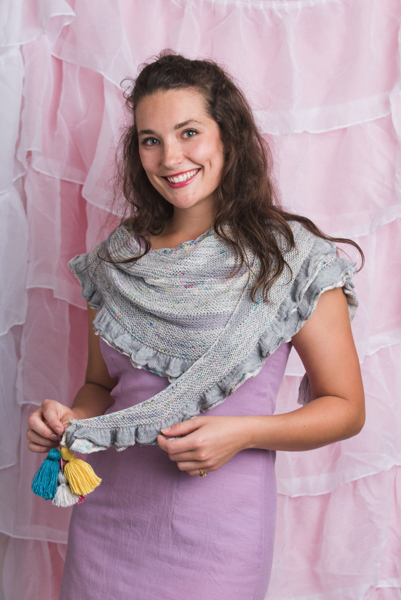
The Tier Me Roar Shawl offers a fresh, modern take on a traditionally frilly accessory. Knit using two complementary colors of lace weight yarn, this shawl boasts an ethereal, light-as-air quality with a beautiful drape and flow. The tiered design creates a stunning texture, giving the shawl a playful yet elegant look. Optional tassels at the ends add a fun, contemporary flair, perfect for those who love a quirky twist to their wardrobe. Whether you’re wearing it for a special occasion or as a stylish layer for everyday wear, the Tier Me Roar Shawl provides an eye-catching accessory that’s as versatile as it is fashionable.
Skill Level: Easy
Size: 14.5” / [36 cm] deep x 68” / [173 cm] wingspan
Gauge: 35 sts and 40 rows = 4” [10 cm] in St st using smaller needles after wet blocking.
20 sts and 36 rows = 4” [10 cm] in Garter st using larger needles after wet blocking.
Materials
 Yarn: Hedgehog Fibres Silk Merino Lace (50% Merino, 50% Silk; 766 yards [700 meters]/100 grams): Peek A Boo (C1, 1 skein)
Yarn: Hedgehog Fibres Silk Merino Lace (50% Merino, 50% Silk; 766 yards [700 meters]/100 grams): Peek A Boo (C1, 1 skein)
Fyperspates Sumptious Lace (55% Merino; 45% Silk; 1094 yards [1000 meters]/100 grams): Slate (C2, 1 skein).
Scraps (approx 10 meters each) of blue, yellow, pink lace weight yarn to make tassels if desired.
Needles: US size 6 (4 mm) 47” / [120 cm] circular, two US size 3 (3.25 mm) 47” / [120 cm] circulars.
Notions: Tapestry needle
Abbreviations
Cdd (Centered double decrease): Slip 2 stitches together knitwise, k1, pass slipped stitches over.
M1-r (Increase 1 st right leaning): With LH needle, pick up bar between the last st and next st from the back to the front. Knit into the front of this st.
Special Stitches
German Short Rows (SR)
Note: I used the German method of creating short rows in the shawl. Use whichever method you prefer. If you are working the “wrap and turn”, work this at the turning point and ignore the “SR” instruction at the start of the following row, then work the wrapped stitches together with their wraps as you come to them. As you are working in garter st, the wraps don’t need to be hidden as they will blend in.
WS is facing. Bring yarn to the front, sl st p-wise and bring yarn up, over and back to pull on the slipped st until it slides around to show two legs. Keeping the yarn at the back in order to k next st while keeping the tension. When working the stitch, the next time you meet it, work the “doubled stitch” (the two legs showing) as if they were one stitch, that is, work the two legs together.
Pattern Notes
The shawl is knit flat. The extra-long needles are needed to accommodate the shawl’s length.
Pattern
Ruffles
With C1 and smaller needles, CO 900 sts.
Rows 1-10: Work in St st.
Row 11 (RS, Dec): *Cdd; rep from * until end of row. (300 sts)
Rows 12-16: Work in St st.
Leave sts on needle and set aside.
With C2 and smaller needles, CO 900 sts.
Rows 1-10: Work in St st.
Row 11 (RS, Dec): *Cdd; rep from * until end of row. (300 sts)
Row 12: Purl
Leave sts on needle.
Body of Shawl
Joining Ruffles
Row 1 (RS): With both yarns held together and with both smaller needles holding the Ruffles in your left hand, use the larger needle to knit first stitch of both smaller needles together. (This is similar to the first step of a three needle bind off.) Work all stitches in this way. (300 sts)
Short Row wedges
Row 2: Sl 1, k238 pm, k1, k2tog, turn work.
Row 3: Sl 1, k1, sm, m1-r, k until 4 sts rem, turn work.
Row 4: SR, k3, pm, k to next marker, sm, k1, k2tog, turn.
Row 5: Sl 1, k1, sm, m1-r, k to marker, remove marker, turn work.
Rep Rows 4 and 5 to establish pattern.
Work Stripes as follows and continuing to work the k2tog with both yarns in order to carry yarns along when not in use and create a stronger join.
Rows 21-30: Work with C2 only.
Rows 31-50: Work with both yarns held together.
Rows 51-60: Work with C1 only.
Rows 61-70: Work with C2 only
Rows 71-100: Work with both yarns held together.
Rows 101-110: Work with C1 only.
Rows 111-120: Work with both yarns held together.
Row 121: Knit to end of row, ensuring to work the “doubled stitch” as if it were one. (300 sts)
Row 122: *K1, K2tog; rep from * until end of row. (200 sts)
BO all sts.
Finishing
Weave in all ends.
Block Shawl to dimensions.
Make Tassels
Make one 3” tassels in each of pink, blue, yellow and C1. With C1, make one 2” and one 1” tassel. Leave long threads for attaching tassels to the Shawl.
Sew one 3” C1 tassel to the right-hand side of the shawl, using the photos as guidance.
Sew the 2” C1 tassel to the left-hand side.
With the remaining 4 tassels, braid or twist the strings together before attaching to the shawl on the left-hand side, allowing the tassels to hang loosely.


